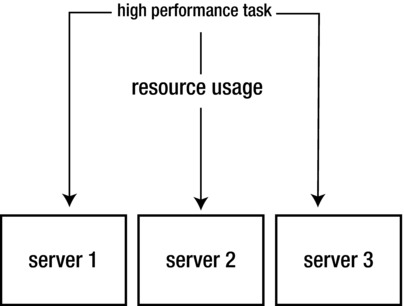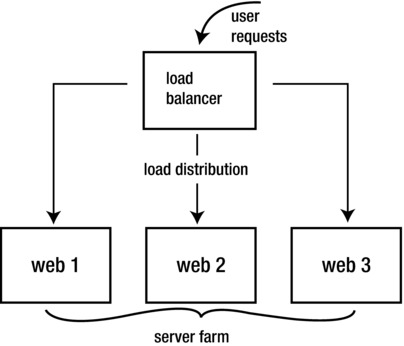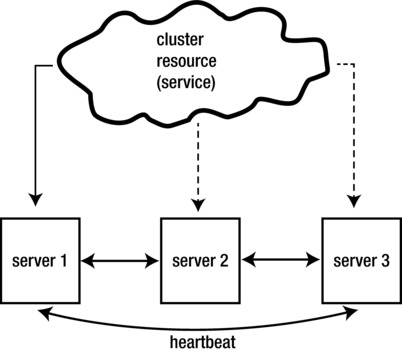In this chapter, youll learn how high availability (HA) clustering relates to other types of clustering. Youll also read about some typical use cases for HA clustering. After a discussion on the general concepts of HA clustering, youll read about its different components and implementations on Linux.
Different Kinds of Clustering
Roughly speaking, three different kinds of cluster can be distinguished, and all of these three types can be installed on Linux servers.
High performance : Different computers work together to host one or more tasks that require lots of computing resources.
Load balancing : A load balancer serves as a front end and receives requests from end users. The load balancer distributes the request to different servers.
High availability : Different servers work together to make sure that the downtime of critical resources is reduced to a minimum.
High Performance Clusters
A high performance cluster is used in environments that have heavy computing needs. Think of large rendering jobs or complicated scientific calculations that are too big to be handled by one single server. In such a situation, the work can be handled by multiple servers, to make sure it is handled smoothly and in a timely manner.
An approach to high performance clustering is the use of a Single System Image (SSI). Using that approach, multiple machines are treated by the cluster as one, and the cluster just allocates and claims the resources where they are available (Figure ). High performance clustering is used in specific environments, and it is not as widespread as high availability clustering.
Figure 1-1.
Overview of high performance clustering
Load Balancing Clusters
Load balancing clusters are typically used in heavy-demand environments, such as very popular web sites. The purpose of a load balancing cluster is to redistribute a task to a server that has resources to handle the task. That seems a bit like high performance clustering, but the difference is that in high performance clusters, typically, all servers are working on the same task, where load balancing clusters take care of load distribution, to get an optimal efficiency in task-handling.
A load balancing cluster consists of two entities: the load balancer and the server farm behind it. The load balancer receives requests from end users and redistributes them to one of the servers that is available in the server farm (Figure ). On Linux, the Linux Virtual Server (LVS) project implements load balancing clusters. HAProxy is another Linux-based load balancer. The load balancers also monitor the availability of servers in the server farm, to decide where resources can be placed. It is also very common to use hardware for load balancing clusters. Vendors like Cisco make hardware devices that are optimized to handle the load as fast and efficiently as possible.
Figure 1-2.
Overview of load balancing clusters
High Availability Clusters
The goal of a high availability cluster is to make sure that critical resources reach the maximum possible availability. This goal is accomplished by installing cluster software on multiple servers (Figure ). This software monitors the availability of the cluster nodes, and it monitors the availability of the services that are managed by the cluster (in this book, these services are referred to as resources ). If a server goes down, or if the resource stops, the HA cluster will notice and make sure that the resource is restarted somewhere else in the cluster, so that it can be used again after a minimal interruption. This book is exclusively about HA clusters.
Figure 1-3.
Overview of high availability clusters
What to Expect from High Availability Clusters
Before starting your own high availability cluster project, it is good to have the appropriate expectations. The most important is to realize that an HA cluster maximizes availability of resources. It cannot ensure that resources are available without interruption. A high availability cluster will act on a detected failure of the resource or the node that is currently hosting the resource. The cluster can be configured to make the resource available as soon as possible, but there will always be some interruption of services.
The topic of this book is HA clustering as it can be used on different Linux distributions. The functionality is often confused with HA functionality, as it is offered by virtualization solutions such as VMware vSphere. It is good to understand what the differences and similarities between these two are.
In VMware vSphere HA, the goal is to make sure that virtual machines are protected against hardware failure. vSphere monitors whether a host or a virtual machine running on a host is still available, and if something happens, it makes sure that the virtual machine is restarted somewhere else. This looks a lot like Linux HA Clustering. In fact, in , youll even learn how to use Linux HA clustering to create such a solution for KVM Virtual machines.
There is a fundamental difference, though. The HA solution that is offered by your virtualization platform is agnostic on what happens in the virtual machine. That means that if a virtual machine hangs, it will appear as available to the virtualization layer, and the HA solution of your virtualization layer will do nothing. It also is incapable of monitoring the status of critical resources that are running on those virtual machines.
If you want to make sure that your companys vital resources have maximum protection and are restarted as soon as something goes wrong with them, youll require high availability within the virtual machine. If the virtual machine runs the Windows operating system, youll need Windows HA. In this book, youll learn how to set up such an environment for the Linux operating system.
History of High Availability Clustering in Linux
High availability in Linux has a long history. It started in the 1990s as a very simple solution with the name Heartbeat. A Heartbeat cluster basically could do two things: it monitored two nodes (and not more than two), and it was configured to start one or more services on those two nodes. If the node that was currently hosting the resources went down, it restarted the cluster resources on the remaining node
Heartbeat 2.0 and Red Hat Cluster Suite
There was no monitoring of the resources themselves in the early versions of Heartbeat, and there was no possibility to add more than two nodes to the cluster. This changed with the release of Heartbeat 2.0 in the early 2000s. The current state of Linux HA clustering is based in large part on Heartbeat 2.0.












